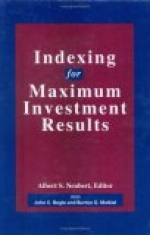Twenty four years after investment managers decided to implement Standard & Poor's 500 indexing strategy, the verdict is in. The first indexers beat more than 99% of all actively managed stock funds. Over the last ten years, funds based on the S&P 500 out-performed more than 80% of all mutual funds. Today about $450 billion is indexed to the S&P 500, almost 10% of the total market value of all stocks traded in the US. The strategy has been applied to other asset classes, including bonds and real estate. In total, indexing now accounts for more than 25% of the investment methodology of all pension funds in the US. Topics include: choosing a benchmark; overview of the marketplace; using derivatives to index; performance track record versus active management; index methodology and other styles; and index price effects on constituent securities. Albert S. Neubert is director of the Domestic S&P Indexes Unit within the Equity Services Group.
Preface
Contributors
Chapter 1. : Why the Case for Indexing Remains Strong
Chapter 2. : Benchmarks : Definitions and Methodologies
Chapter 3. : The First Index Mutual Fund
Chapter 4. : Optimal Indexing
Chapter 5. : Enhanced Indexing¯Without Enhanced Risk?
Chapter 6. : Choosing A Benchmark
Chapter 7. : The “S&P Effect” Has Moved Beyond the S&P Composite
Chapter 8. : The S&P500 is Not Your Father’s Index
Chapter 9. : Performance Track Record Versus Active Management
Chapter 10. : Overview of the Equity Index Fund Marketplace
Chapter 11. : Implementing Equity Index Portfolios
Chapter 12. : Adding Value Through Equity Style Management
Chapter 13. : Using Style Analysis to Build Completeness Funds
Chapter 14. : Index Shares
Chapter 15. : Fixed-Income Indexing
Chapter 16. : The Tax Advantages of Indexing
Chapter 17. : Optimizing Performance
Chapter 18. : The Licensing of Financial Indexes : Implications for the Development of New Index-Linked Investment Products
Index

























